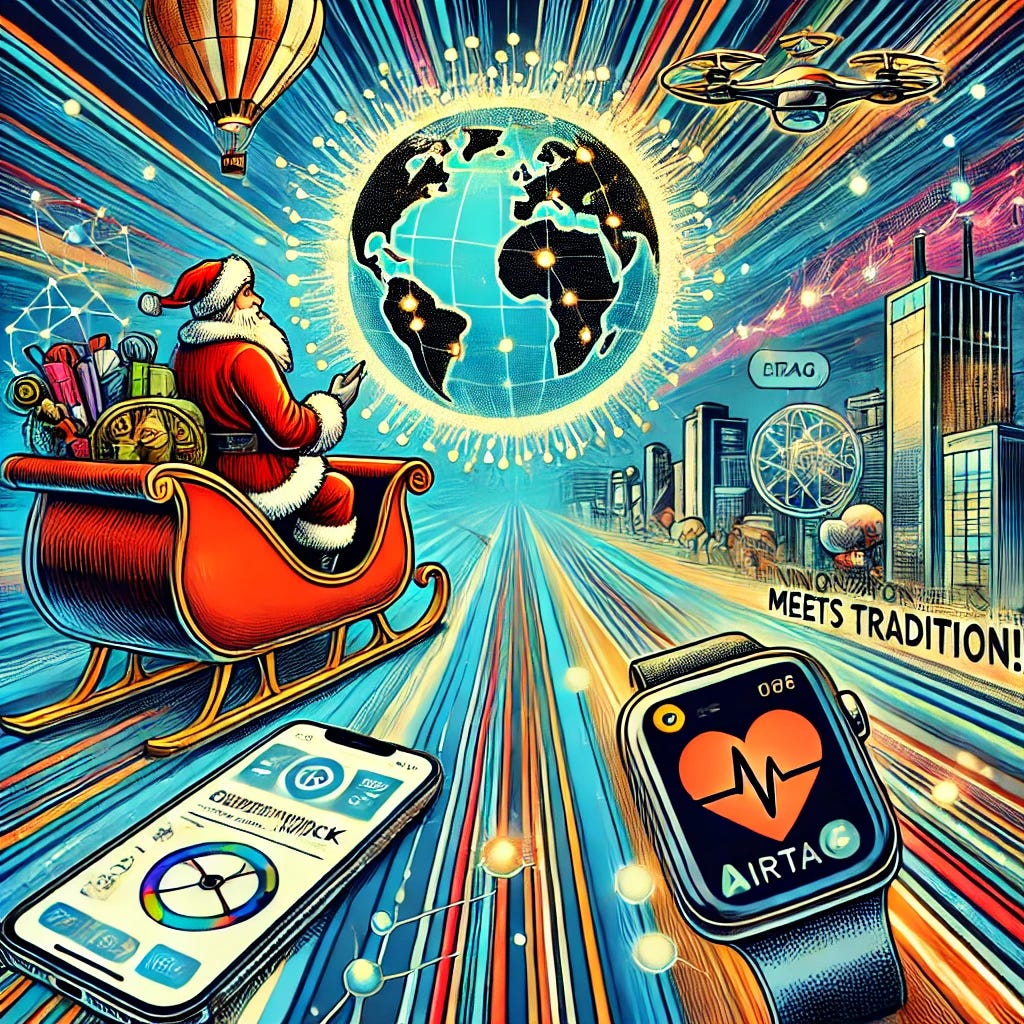The Comunicano for Monday December 23rd 2024
Imagine a world where tradition meets innovation, where magic finds its place alongside technology. That world exists, and it’s all around us….Take the NORAD Santa Tracker. Since 1955, it’s been lighting up Christmas Eve for kids everywhere. What started as a wrong number became a right moment—a chance for families to follow Santa’s journey in real-time. With a click or a call, children see the magic unfold, mile by mile, and belief gets a boost from technology.
And speaking of innovation, let’s talk about quantum teleportation. Northwestern University researchers have achieved what sounds like science fiction. Over existing fiber optic cables, they’ve sent qubits—quantum bits—securely and reliably. It’s the kind of breakthrough that changes everything, laying the foundation for a future where quantum communication doesn’t just coexist with the internet—it transforms it…..Meanwhile, Apple is reshaping how we connect with our world and ourselves. Their AirTags, simple and affordable, keep travelers sane during the chaotic holiday season, while whispers of new AirPods Pro with health-tracking features suggest we’re only beginning to explore what wearables can do for us. Heartbeats, body temperature—soon, they’ll tell us more about ourselves than we ever imagined.
But not all tech tales are seamless. A drone show in Orlando crashes to earth, a reminder that progress comes with growing pains. And as AI reshapes industries, traditional media struggles to keep up, raising questions about what the future holds for storytelling….So here we are, at the crossroads of magic and machinery, of dreams and innovation. What we do next matters. We can choose to be awed, inspired, and careful—to let the marvels of this age bring us together. Or we can let them divide us.
The choice, as it always has been, is ours. And you can learn how to decide, simply by reading, THE COMUNICANO!!!
Andy Abramson
Santa Watch
Santa Claus is Coming to Town—The NORAD Santa Tracker, a Christmas Eve tradition since 1955, lets children follow Santa's journey in real-time. Originally started due to a misprinted phone number, it evolved into a beloved custom. NORAD's tracker, available online and via app, activates December 24, showing Santa's path from 6 a.m. to 2 a.m. ET Christmas Day. Families can also call 1-877-HI-NORAD for updates. Google offers a similar tracker, with games and countdowns leading up to Santa's travels. Both tools blend festive fun with technology, keeping the magic alive for children worldwide.
Quantum Watch
Beam Me Up- Northwestern University researchers have achieved quantum teleportation over 30.2 km of existing internet fiber optic cables, transmitting qubits via quantum entanglement alongside conventional internet traffic at 400 Gbps. This breakthrough disproves the need for separate infrastructure for quantum communication, using specialized filters and wavelength management to avoid interference. The experiment marks a 90% success rate, with a 10% error margin needing refinement. This milestone paves the way for integrating quantum networks into existing frameworks, advancing secure communication and quantum computing technologies while moving closer to a unified quantum-classical communication infrastructure.
Apple Watch
Let’s Play Tag—Apple's $29 AirTags have become indispensable for travelers aiming to keep tabs on their luggage during the holiday season. These compact trackers utilize a vast network of Apple devices to pinpoint lost items, often more efficiently than airlines. Notably, airlines such as United and Delta now allow passengers to share their AirTag-tracked luggage locations directly with them. To optimize performance, place the AirTag inside your bag near the outer edge to minimize signal obstruction, and ensure your Apple devices are updated to the latest iOS version. Activating Lost Mode in the Find My app provides real-time location updates if your luggage goes astray. Additionally, consider alternatives like Pebblebee or Chipolo for tracking needs. Despite technological aids, traditional precautions—such as clearly labeling your bags and displaying contact information—remain crucial for seamless travel.
Getting To The Heart of The Matter—Apple is reportedly developing the next generation of AirPods Pro, aiming to introduce advanced health monitoring features by 2025. These enhancements may include heart rate sensors capable of measuring pulse via the ear canal, potentially offering more accurate readings than wrist-based devices. Additionally, body temperature sensors are expected, providing precise measurements through the ear. These developments align with Apple's broader strategy to integrate comprehensive health-tracking capabilities into its wearable devices, enhancing user health insights and monitoring.
GovTech Watch
Changing The Game—Palantir Technologies and Anduril Industries are teaming up with tech heavyweights like SpaceX, OpenAI, Scale AI, and others to form a consortium bidding for U.S. government defense contracts. Announcements are expected in January, as the group aims to redefine defense contracting with Silicon Valley's cutting-edge tech, including AI, autonomous systems, and drones. This alliance targets inefficiencies in legacy programs like Lockheed Martin's F-35, advocating instead for cost-effective, AI-driven solutions. This shift reflects a broader push for innovation in Pentagon spending, challenging traditional defense contractors while modernizing U.S. military capabilities.
AI Watch
Gemini Grows Up—Google's recent introduction of Gemini 2.0, an advanced AI model with capabilities like real-time internet access and native image and audio generation, has expanded its AI offerings. However, the addition of multiple models—such as Gemini 2.0 Flash Experimental, Gemini 2.0 Experimental Advanced, and Gemini 1.5 Pro with Deep Research—has introduced complexity for users. Selecting the appropriate model for specific tasks now requires understanding the distinct functionalities of each, potentially complicating the user experience. This development raises questions about the balance between AI sophistication and user accessibility.
Delivering Bad News—Pal Om Malik's December 21 post reflects on how artificial intelligence (AI) is reshaping the media landscape. He critiques traditional media's failure to adapt to digital disruption, comparing it to their earlier missteps with Google and Facebook. Malik highlights the existential threat posed by AI platforms, like OpenAI and Claude, which summarize and atomize content, undermining legacy traffic and ad-based revenue models. He underscores the decline of meaningful discovery in favor of algorithm-driven engagement and advertising, cautioning that AI's one-to-one interaction model could make traditional media obsolete. Malik advocates rethinking media's purpose in the AI age to secure a sustainable future.
Cha..Cha..Changes—Ethan Mollick's blog highlights a transformative period in AI, with the emergence of advanced models like GPT-4-class AIs and new Gen3 systems. AI capabilities are now widespread, from running on home computers to aiding research and problem-solving at PhD levels. Breakthroughs include o1, which can "think" before answering, revolutionizing fields like medical diagnosis and academic research. Vision-enabled AI models like Gemini 2.0 bring real-time interaction, blending visual and auditory inputs. This rapid advancement is reshaping the landscape, making AI a vital collaborator in various domains, though challenges in evaluating accuracy remain significant.
Meta Watch
Getting A Bigger View—Meta plans to integrate displays into its Ray-Ban smart glasses by 2025, aiming to accelerate its push into augmented reality (AR) and wearable tech. These $300 glasses, developed with EssilorLuxottica, will feature simple text and image notifications via a Meta virtual assistant. This move complements Meta's AR prototype "Orion," which offers advanced features like 3D overlays and neural interface controls. Despite challenges like high costs and supply chain issues, Meta views this as a step toward lightweight, consumer-friendly AR devices. With increased sales of Ray-Bans and advancements in AI, Meta aims to lead the race against Apple and Google in the smart glasses market.
TikTok Watch
The End—The potential TikTok ban by January 19 threatens to upend the U.S. creator economy, valued at $250 billion, where TikTok plays a central role. Influencers like James Nord of Fohr call it an "extinction-level event" for many creators, as TikTok’s 170 million U.S. users represent a hub for lucrative brand deals. Despite Supreme Court hearings on its constitutionality, lawmakers press Google and Apple to prepare for removal. Influencers are urging followers to migrate to Instagram or YouTube, though their followings often pale in comparison. With limited alternatives and no government support, a ban could shutter countless creator livelihoods overnight.
X Watch
Price Change Coming—Elon Musk's platform X (formerly Twitter) is raising the price of its ad-free Premium+ subscription by 40%. Starting January 20, 2025, existing subscribers will pay $22/month (up from $16) or $229/year (up from $168). The price hike supports creator payouts and includes new perks like priority support, a keyword monitoring tool (Radar), and increased Grok AI limits. Despite these enhancements, the timing is contentious, as X faces user migration to alternatives like Bluesky. The platform aims to balance revenue growth and creator support while navigating user dissatisfaction with rising costs.
Drone Watch
Crash Time—A holiday drone show at Lake Eola in Orlando ended in chaos when drones malfunctioned mid-performance, crashing into the crowd. One person was hospitalized with minor injuries, and city officials canceled the second show due to "technical difficulties." The FAA is investigating the incident, focusing on drone collision causes and compliance with safety regulations. This mishap highlights risks associated with drone shows, especially in crowded areas. Disney, known for innovative entertainment, may face challenges incorporating drone shows into its parks due to safety concerns and crowd management complexities. Such events require rigorous planning to ensure safety and reliability.






